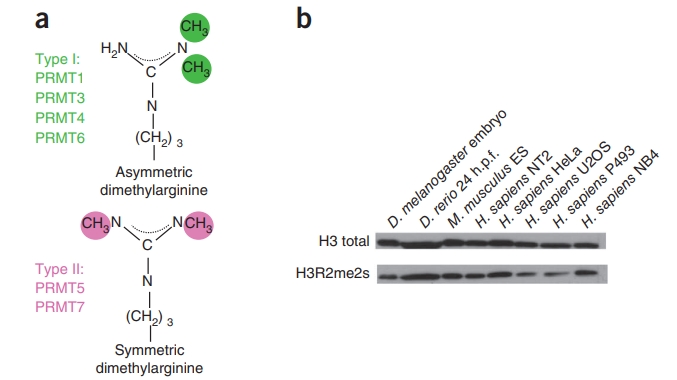Histone Symmetric Dimethylation Analysis Service
Based on a high-resolution liquid chromatography–tandem mass spectrometry (LC-MS/MS) platform combined with specific modified peptide enrichment strategies, the histone symmetric dimethylation analysis service launched by MtoZ Biolabs enables precise detection and quantitative analysis of symmetric dimethylation (sDMA) modifications on histone arginine residues. This service can systematically identify sDMA modifications at different sites and compare their abundance under various conditions. By integrating bioinformatics analysis, it provides data on modification site distribution, quantitative results, and functional annotation, helping researchers to explore the role of sDMA in epigenetic regulation and cellular functions.
Overview
Histone symmetric dimethylation (sDMA) refers to a post-translational modification in which a methyl group is added to each of the two nitrogen atoms on an arginine residue, with key residues including H3R2 and H4R3, conferring unique regulatory functions. sDMA plays a crucial role in maintaining chromatin structure, regulating gene transcription, and RNA processing, and is closely associated with cellular differentiation, signal transduction, and immune regulation. Histone symmetric dimethylation analysis allows systematic detection and quantitative analysis of sDMA modifications, and is widely applied in epigenetics, cellular function studies, and potential biomarker research, providing reliable data support.

Migliori, V. et al. Nature Structural & Molecular Biology, 2012.
Figure 1. Asymmetric and Symmetric Dimethylarginines and Levels of H3R2me2s in the Chromatin of Different Organisms.
Analysis Workflow
1. Histone Extraction and Digestion
Isolate histones from cell or tissue samples and perform enzymatic digestion under optimized conditions to generate detectable peptides.
2. Modified Peptide Enrichment
Use specific strategies to enrich symmetric dimethylated peptides, improving detection sensitivity and coverage.
3. LC-MS/MS Detection
Utilize a high-resolution liquid chromatography–tandem mass spectrometry platform to accurately identify and quantify sDMA modification sites.
4. Data Analysis
Integrate bioinformatics tools to output modification distribution, abundance differences, and functional annotation, supporting in-depth research.
Sample Submission Suggestions
1. Sample Type and Quantity

Note: Plasma should be collected using EDTA as an anticoagulant. Standard tissue or cell lysis buffers can be used during protein extraction.
2. Sample Transportation
Avoid repeated freeze-thaw cycles. Samples are recommended to be stored at -80°C and transported on dry ice to ensure low-temperature conditions throughout the process and prevent modification loss.
Note: For special samples or if a detailed submission plan is required, please contact MtoZ Biolabs technical staff in advance.
Service Advantages
1. High-Resolution Detection
Based on an advanced LC-MS/MS platform, capable of accurately identifying low-abundance symmetric dimethylation modifications.
2. Efficient Enrichment Method
Employ optimized peptide enrichment strategies to significantly improve the detection rate and coverage of sDMA modifications.
3. One-Stop Analysis
Provide a complete workflow from sample processing to data analysis, simplifying the experimental procedure.
4. Customized Solutions
Flexibly design experimental workflows according to research objectives and sample types to meet diverse scientific needs.
Applications
1. Epigenetics Research
Histone symmetric dimethylation analysis service can be used to analyze the role of sDMA modifications in maintaining chromatin structure and regulating gene transcription.
2. Signal Transduction Research
By analyzing sDMA involved in the regulation of cellular signaling pathways, this service helps to explore its mechanisms of action.
3. Cell Differentiation and Development Research
Histone symmetric dimethylation analysis service can be applied to study the dynamic changes of sDMA during stem cell differentiation and tissue development.
4. Potential Biomarker Discovery
By identifying sDMA features associated with specific conditions, this service contributes to the discovery of new functional molecular biomarkers.
FAQ
Q1: How Can Symmetric Dimethylation Be Distinguished from Asymmetric Dimethylation?
A1: We differentiate them through specific enrichment strategies combined with the fragment ion characteristics of high-resolution LC-MS/MS. When necessary, control experiments and targeted analyses are applied to ensure the accuracy of the results.
Q2: Does This Service Support Joint Analysis with Other Epigenetic Modifications?
A2: Yes. It can be combined with studies on monomethylation, trimethylation, and acetylation to reveal synergistic or antagonistic interactions among different modifications.







